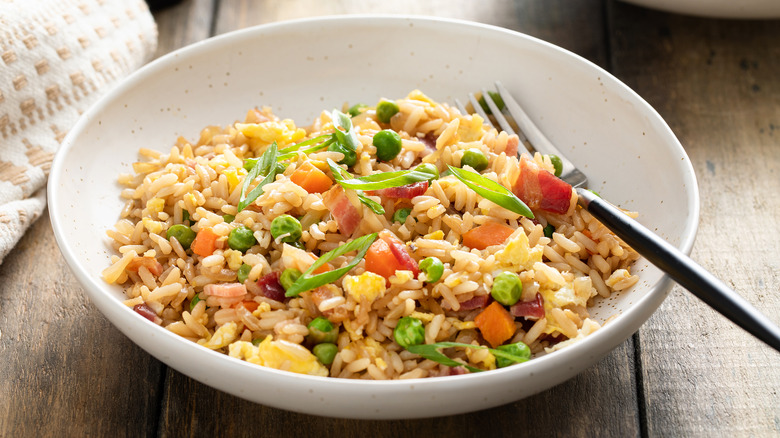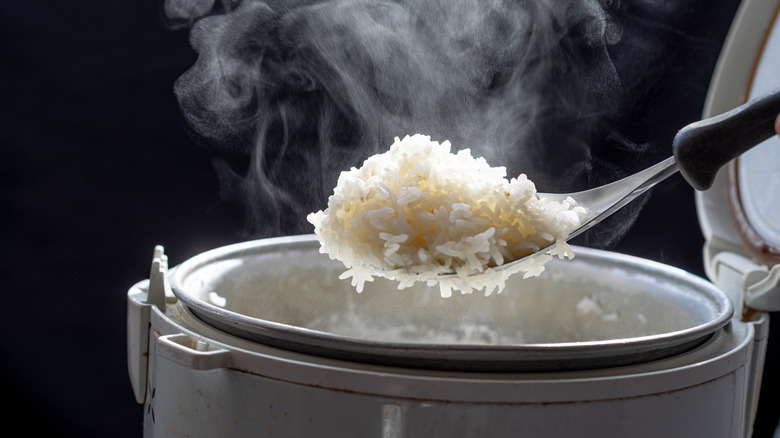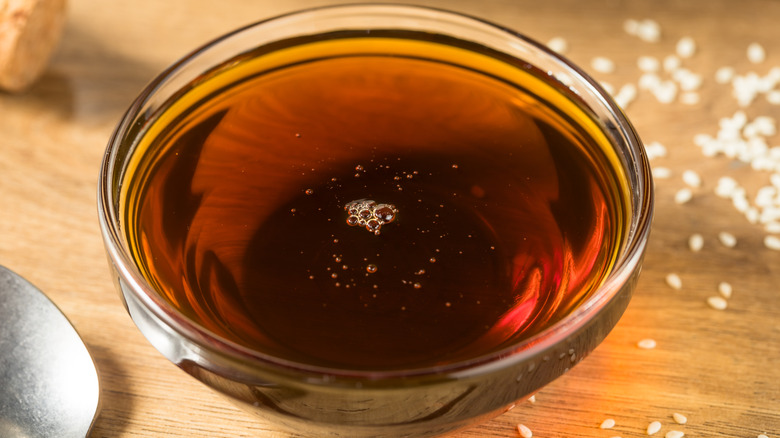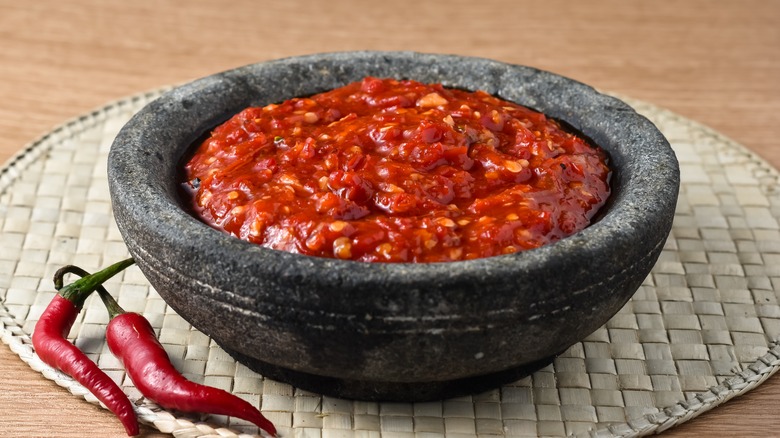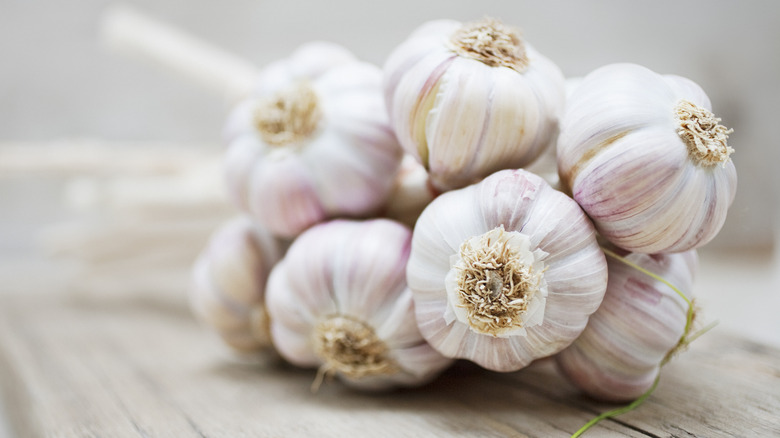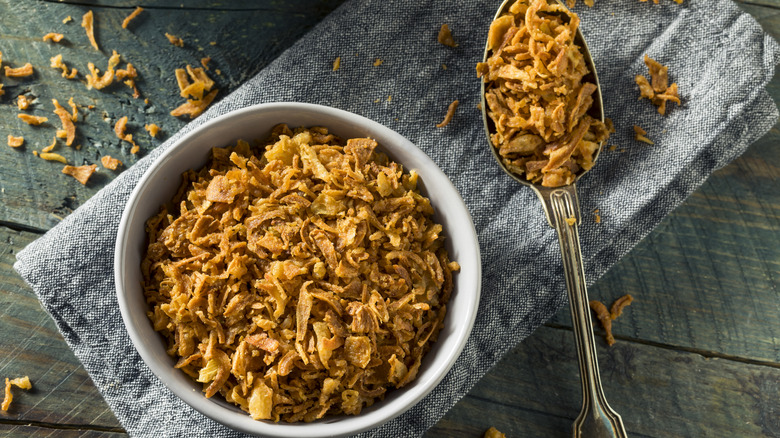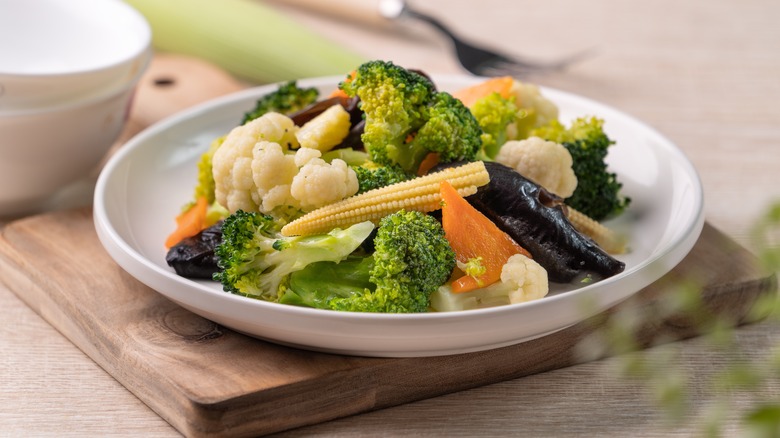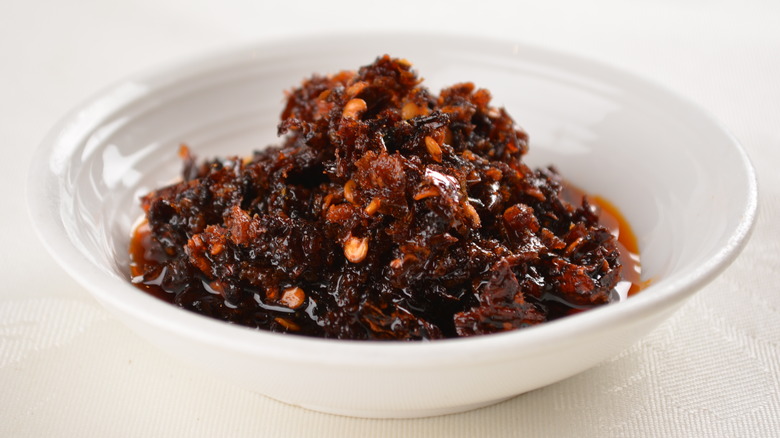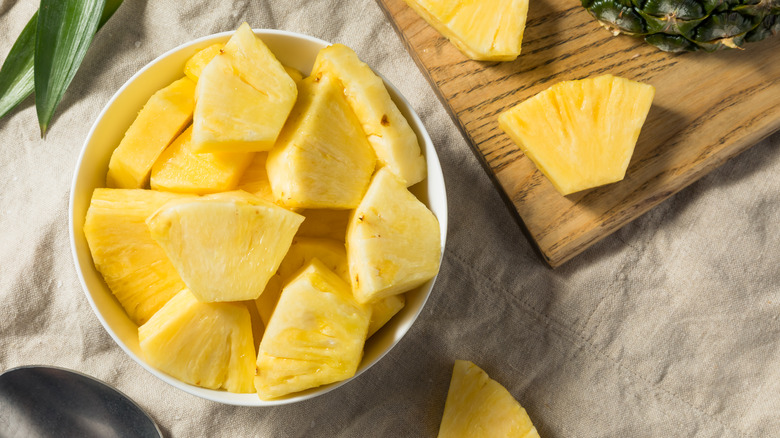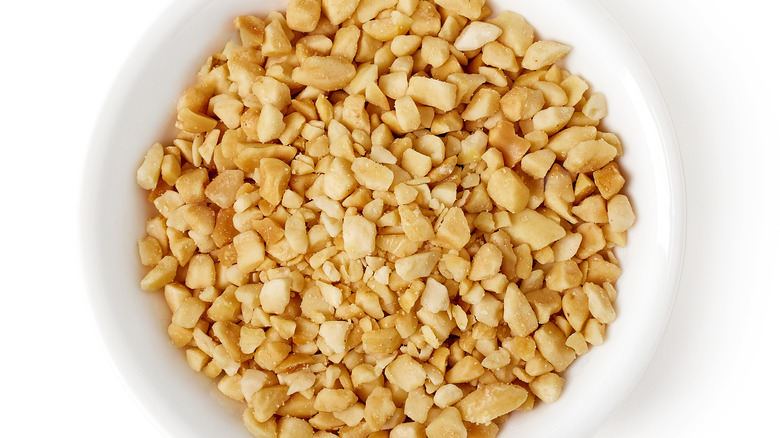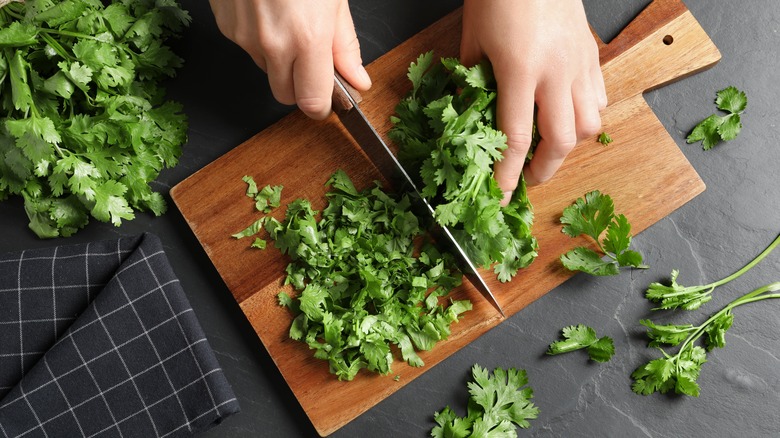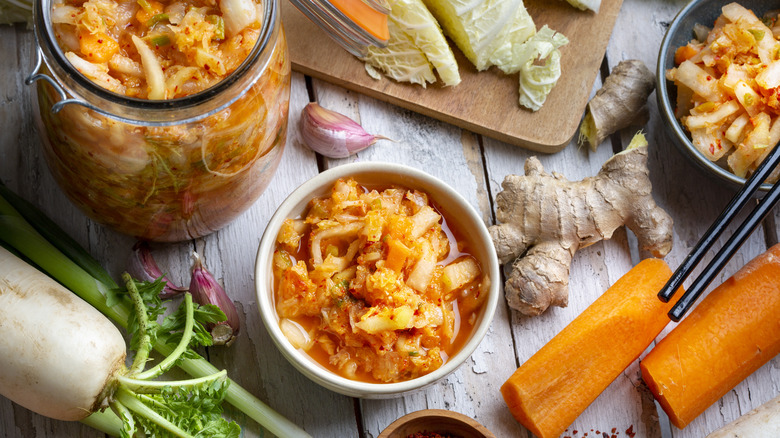Delicious Ingredients That Will Upgrade Your Fried Rice
Fried rice is a simple and tasty item that perfectly accompanies an array of dishes. It's super versatile and can be found on just about any Chinese, Japanese, Thai, or Korean menu. Fried rice can even be served as the main event (if it's done right).
In its most basic form, fried rice consists of little more than rice, soy sauce, cooking oil, and egg. However, you can easily incorporate a host of additional ingredients to upgrade any fried rice recipe.
Even though fried rice is fairly easy to make at home, it somehow never tastes as good as what you'd order from a restaurant — but that's about to change. We've assembled a list of delicious ingredients that will upgrade your fried rice — whether it's prepared as a side dish or the main course. Keep reading to learn how to instantly transform boring, bland fried rice into a drool-worthy dish.
1. Start with day-old rice
What's the absolute best way to upgrade your homemade fried rice? Use day-old rice. This may seem too easy, but it makes a world of difference when it comes to frying potential and consistency. Starting with day-old rice allows the individual grains to dry out so they resist clumping and retain the perfect texture for fried rice. Using long-grain rice, particularly jasmine rice, is also recommended ... as long as it's at least one day old, of course.
Frankly, preparing the rice a day or two in advance allows you to skip the most time-consuming step when it comes to cooking the actual fried rice. Of course, while this upgrade hack is simple, it does require a bit of foresight or meal planning. You can still use fresh rice if you find yourself spontaneously craving it for dinner. But if you're able to do so? It's always better to use leftover rice for fried rice.
2. Sugar
Even if you've made fried rice before at home, you may have been missing a key ingredient: sugar. On that note, if you've ever wondered why your homemade version doesn't taste quite like the fried rice you'd get at a restaurant, a lack of sugar may be the culprit. This secret ingredient is apt to upgrade your next batch of fried rice like no other — and you only need a little bit to achieve that goal (fried rice isn't supposed to taste sweet, after all).
Adding sugar to fried rice can help balance and spread the spicy, salty, and umami flavors throughout the entire dish. Plus, sugar can cause veggies and rice to start caramelizing while in the frying pan, leading to a deeper, richer taste.
You can use whatever kind of sugar you have in your kitchen, and remember: You don't need much. For instance, a quick fried rice recipe with 2 cups of long-grain rice only calls for a single tablespoon of sugar.
3. Sesame oil
Aromatic and bold, sesame oil is an obvious choice if you want to upgrade your fried rice. Its rich, buttery, nutty taste mixes well with different kinds of rice and a broad range of other ingredients, as well. In addition, sesame oil and soy sauce are an iconic duo used in a myriad of Asian dishes; some might even say adding sesame oil and soy sauce to a dish is the best way to give it an Asian flavor.
Sesame oil helps balance the saltiness of soy sauce while still allowing both flavors to shine. But you don't necessarily want to cook your entire fried rice dish with sesame oil. Vegetable or olive oils may be more readily available than sesame oil in some places, and each has a higher smoke point than sesame oil, as well — meaning you don't have to keep your rice cooking over lower heat the entire time (as with sesame oil).
Instead, adding a drizzle of sesame oil or even sesame paste to your fried rice after it cooks may be your best course of action. Sesame seeds also make a yummy garnish, though they don't taste quite the same or add nearly as much flavor as sesame oil.
4. Chili sauce
Chili sauce is a standard Asian condiment used in (or on) a range of different dishes. While there are many variations, chili sauce often falls into two categories: sweet chili sauce and chili crisp. Both sauces are spicy and contain garlic, but chili crisp tends to have more garlic and contains crunchy bits, while sweet chili is kind of, well, sweet (obviously). Whichever you prefer, you can add chili sauce to fried rice while it's cooking or wait and use it as a garnish at the end.
Adding it at the end may be best if you're cooking fried rice for other people. That way, each person can use the chili sauce as generously or as sparingly as they prefer. You'll want to make sure you add the sauce gradually and test the heat level as you go; otherwise, you may accidentally create an unbearably hot dish.
Both sweet chili and chili crisp sauces work wonderfully with fried rice and are available at most grocery stores, so they're easy to acquire. Many Asian markets offer an abundance of different brands and variations, too, so they may be the best place to find delicious chili sauces. If you want to test your home chef skills, you can also make sweet chili sauce or chili crisp from scratch, as well. Either way, If you like your fried rice with a bit of heat, chili sauce is a quick, easy, delicious way to add that element.
5. Garlic
Pungent in flavor and aroma, garlic is another outstanding way to upgrade fried rice. It isn't considered one of the essential ingredients for plain fried rice, but it's used in almost every authentic recipe and restaurant. Garlic is also extremely popular in Asian countries, so it just makes sense in fried rice. It's particularly prevalent in China given its use in traditional Chinese medicine as a way to potentially improve one's overall health.
When it comes to fried rice, fresh garlic is always best. It has a bold flavor and an aromatic smell that enhances the dish before you take a single bite. Simply peel and chop a couple of cloves and add them to your skillet with the other ingredients. To preserve flavor and avoid burning, wait until the dish is almost done. It should only take a couple of minutes for the taste to spread throughout the dish.
If you don't have any fresh garlic on hand, you can also use minced garlic from a jar or powdered garlic. However, some of these products have a milder taste, so you may want to increase the amount used if you want garlic to stand out from the other spices and ingredients in your fried rice.
6. Crispy fried onions
Onions and fried rice are a no-brainer combination, and you'll often find grilled white onions and chopped green onions in the dish. But what about their crispy fried counterparts? If you're one of the many who view crispy fried onions as little more than a component for green bean casserole on Thanksgiving, think again. They're a beyond-delicious food that can also be used to upgrade your fried rice.
Crispy fried onions add a yummy taste and a touch of salt to fried rice while enhancing the texture with their crunch. They don't require any dicing or cooking, making them one of the simplest additions available to boost fried rice's flavor. You can always put crispy fried onions in the pan with other ingredients while frying, of course, but that may significantly soften them — and defeat the entire purpose of using crispy fried onions in the first place.
7. Non-traditional veggies and tofu
Enhancing fried rice with vegetables isn't a new concept — but it is a delicious one. In fact, you've probably already ordered fried rice from a restaurant featuring an array of veggies like cabbage, edamame, snap peas, broccolini, bok choy, baby corn, carrots, water chestnuts, onions, scallions, and mushrooms (to name a few).
While all of these veggies are typical additions, thanks to the versatility of fried rice? You can add just about any vegetable and wind up with a mouth-watering combination — from asparagus to cauliflower to Brussel sprouts (and more).
Another option for upgrading fried rice is tofu. It's not technically a vegetable, but it's derived from soybeans, so it's not too far off. Plus, tofu soaks up all the other flavors in your fried rice without taking over while adding a considerable amount of protein. Frankly, the ability to seamlessly add a ton of tasty veggies (and tofu) to any fried rice dish helps illustrate why Asian cuisine is a great way to bolster a vegan diet.
8. Various types of meat
This may seem obvious, but you can always upgrade plain fried rice with meat. Most Chinese restaurants offer chicken, beef, and pork fried rice, after all — with some selling a combination featuring all three types of meat in one.
Adding any meat to your homemade fried rice will create a more complex flavor profile and build a heartier overall plate — one that's perfect as a main course. Aside from the traditional options, you can also get creative and experiment with other kinds of meat. Try using short ribs if you're craving a rich alternative to the standard beef cut used in fried rice.
Spam is another fantastic option. It may not be prevalently used in much of the contiguous U.S., but its super salty nature is perfect for fried rice — and it's a pretty popular food item in many parts of Asia. Chinese sausage and broccolini fried rice is super yummy, for instance, and (as the name suggests) includes a meat typical in Asia.
9. Seafood
Along the same lines as meat, seafood is a simple way to upgrade your homemade fried rice. It's often a bit more decadent than poultry or red meat, so it lends a richer taste to fried rice. Shrimp is the most common seafood added to fried rice, which is evident by the numerous Chinese restaurants offering the dish.
Shrimp tastes excellent with other typical fried rice ingredients, like soy sauce and garlic, and is easy to buy fresh, frozen, or canned. In addition to shrimp, shredded crab meat, scallops, clams, and lobster all taste amazing in fried rice. Considering the prevalence of fish sauce in many areas of Asian cuisine, you could try adding chunks of different kinds of non-shellfish seafood, as well.
Whitefish may be the best choice but don't hesitate to try something new. Of course, seafood isn't a viable option for folks with plant-based diets or those allergic to shellfish, but it can add much-needed protein to those who enjoy it — and elevate boring fried rice into something special.
10. XO sauce
Common in southern China, XO sauce is one of the best ways to add a potent umami flavor to your fried rice. It's typically made with some combination of sausage and a dried seafood mix (which often includes scallops) and offers a bold, spicy flavor that can add instant depth and complexity to your fried rice. Best of all, it's as easy to use as spooning in some sauce.
Depending on where you live, you may be able to pick up a jar of XO sauce at your local grocery store. If not, Asian markets and online retailers may be your best bet. You can also make homemade XO sauce quite easily; however, like buying a pre-made jar, you may need to turn to specialty vendors to find the necessary ingredients. Either way, this simple flavor booster undeniably upgrades fried rice by increasing the heat with its complex flavor profile.
11. Pineapple
Adding fruit to your fried rice may sound a bit strange at first, but pineapple makes a delicious addition. Pineapple blends well with a range of savory ingredients typically found in fried rice, so think of it more like pizza with pineapple (which we know is contentious but loved by many). Pineapple goes well with savory herbs like cilantro and Thai basil and tastes great with soy sauce and garlic, all of which can be added to (or may be found in) fried rice.
Pineapple can be combined with XO sauce to create a sweet-and-spicy fried rice dish that perfectly exemplifies the fruit's abilities. The rich flavors of XO sauce balance wonderfully alongside the pineapple's sweetness. Soy sauce can also be used to temper the sweetness of pineapple in fried rice, and spicy chili sauces and peppers are fantastic options, as well, as the heat can ensure the pineapple doesn't overwhelm the remaining flavors.
12. Thai basil
Thai basil is another common ingredient used in Asian cuisine that makes for a delicious addition to homemade fried rice. Native to Southeast Asia, Thai basil has a distinct taste that's slightly similar to Italian basil — yet is wildly different at the same time. Thai basil is aromatic like regular basil, but it has a spicy, savory taste with a lasting anise flavor – and that complexity can add depth to fried rice while ensuring your dish remains light and bright.
Adding fresh Thai basil to fried rice may work best when done as a finishing garnish. After all, when you use it as a final touch, the flavors stay fresh and herbaceous. Start by adding just a couple of sprigs at first. If you like it, you can always add more as you go.
You can always fry Thai basil with your fried rice if you prefer that preparation and it will still taste delicious. It won't be nearly as vibrant, but it could be slightly more savory, so feel free to play around.
13. Chopped nuts
Chopped or crushed peanuts are a surefire winner when upgrading fried rice. They are a common ingredient in many parts of Asia and add a ton of extra flavor. They're also easy to sprinkle on the top of a bowl of fried rice moments before eating or serving. There's no need to cook them, after all (although you can if you want).
Additionally, peanuts are easy to find at both grocery stores and convenience stores. You can purchase them chopped or buy them whole and crush them yourself at home. Cashews and pine nuts also taste delicious in fried rice. They both have a buttery taste and consistency that mixes well with soy sauce and sesame oil.
Cashews and peanuts may not be nearly as crunchy as peanuts, but both can still enhance the texture throughout an entire dish. One of the only drawbacks to using these two nut varieties is that they tend to be more expensive than other kinds, particularly peanuts. Even so, they're worth trying in your next fried rice batch.
14. Cilantro
When you think of cilantro, Mexican food may be the first thing that comes to mind. But that doesn't mean it's the only type of cuisine in which cilantro tastes good. It may be surprising for some people, but cilantro is quite common in Asian cuisine, as well. It's used in all kinds of traditional dishes — fried rice included. Adding cilantro to your own fried rice results in a serious upgrade to flavor. The lemony, peppery taste stands out and gives your fried rice a pungent, pleasant aroma.
Whenever available, use fresh cilantro, as the dried version tastes nothing like a fresh bundle. Also, when adding cilantro to your fried rice, consider doing so as a garnish. You can cook it into the mix, of course, but it better retains the bright, potent flavor when you sprinkle it on top at the end. Cilantro may not be for everyone (like those folks who abhor the taste). But trust us when we say your fried rice simply won't be the same without it — in the best way possible.
15. Kimchi
Kimchi is a delicious Korean creation that's often served as a side dish. But it makes an incredible addition to a range of meat and vegetable dishes, as well — fried rice included. There are many ways to get creative with kimchi; and while some may not categorize kimchi fried rice as creative, per se, it's still an additional ingredient capable of upgrading any batch of fried rice.
Kimchi and fried rice combine various flavor profiles in a single bowl: sweet, tangy, spicy, umami. Not only that, but kimchi is relatively easy to make at home ... as long as you give it time to ferment. The fermentation process can take anywhere from three days to two weeks, though how long kimchi needs to ferment is dependent on one's preference (the longer it sits, the more intense the flavors become).
Either way, once kimchi is made, it can be added to any fried rice dish to bring a much-loved Korean flavor. Be sure to make use of the leftover kimchi juice once you've eaten all the fermented veggies, too — perhaps by adding the leftover liquid to upgrade your fried rice's overall flavor.
16. Extra soy sauce
We already know soy sauce is one of the key ingredients in making any fried rice dish. However, a little extra can go a long way — especially when it's added alongside some of the delicious ingredients we've already mentioned.
Now, if you're unsure how much soy sauce to add, start with a small amount as a garnish (in addition to the amount used while frying) then taste as you go. You can always add more, after all, but reducing the soy taste is a much more involved process.
Keep in mind: There are plenty of reduced-sodium soy sauces available at the grocery store if you're trying to minimize your salt intake but still want a flavor boost. These products may not be considered truly low sodium by some (given they can still contain roughly 25% of the recommended daily sodium per serving), but they'll provide a salty upgrade without too much additional sodium.

